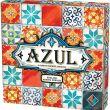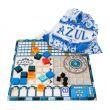Product Information
To start a round, four tiles get drawn from the bag and placed onto each ‘factory’. Players take turns drafting tiles from any factory of their choice. Whenever they pick tiles from a factory, they have to take all tiles of a matching type present there. Those they don’t draft join a new, separate factory. As the round wears on, this separate factory grows in size, but the drafting of tiles rule applies here, too. Players draft tiles until all factories sit empty.
You’re aiming to collect enough of one tile type to fill in thresholds on your player mat. At the end of each round, if you’ve filled up a threshold, you can stick said tile onto the wall! It’s like Sudoku; once you’ve filled one tile-type onto the wall, it can’t repeat on the same row or column. At first, you’ll collect tiles in a laid-back fashion. But the pinch closes in during later rounds. Your options start to become ever-more specific. Other players can take note of your predicaments. Elements of push-your-luck enter the fray. Especially considering there’s the chance you might get left with excess tiles you can’t place! These class as ‘smashed’ tiles… And that means minus-points!
Azul is a quick game to teach, and addictive to play. This fits the category of easy to learn, but tricky to master. It’s easy to see why Azul has become an overwhelming modern classic! Such is Azul’s wild success, it’s spawned two sequels already – Azul: Stained Glass of Sintra, and Azul: Summer Pavilion. Both scratch the same itch, with tile drafting being the core mechanism.





